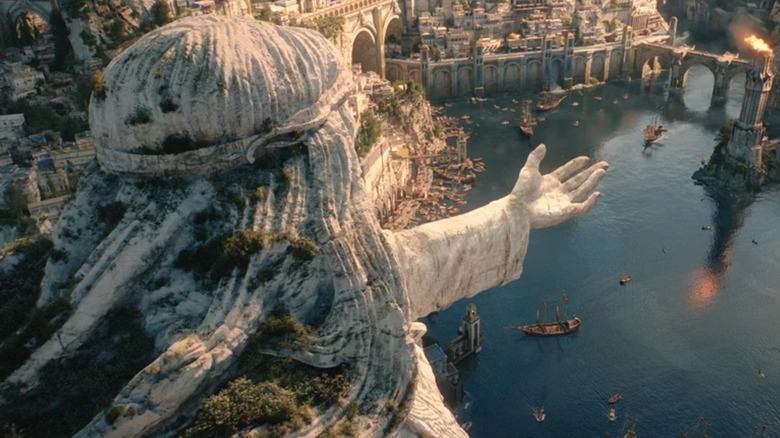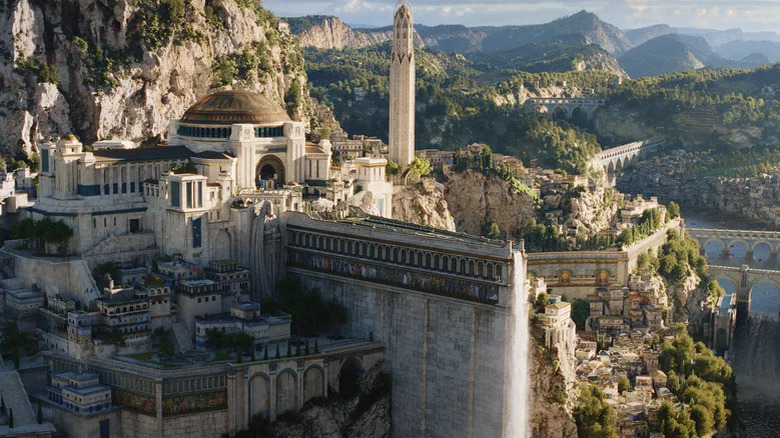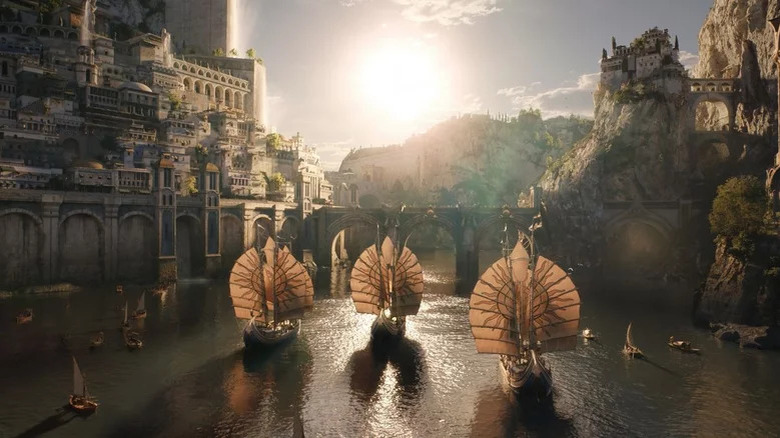Númenor's Design In The Rings Of Power Mixes Myth With Real-Life History [Exclusive]
Spoilers for "The Lord of the Rings: The Rings of Power" through episode 3 and the future of the city of Númenor.
In episode 3 of "The Lord of the Rings: The Rings of Power," Galadriel (Morfydd Clark) and her shipwrecked companion Halbrand (Charlie Vickers) are brought to the fabled island kingdom of Númenor. We see its giant statues and gorgeous seaside architecture and meet some of its doomed inhabitants. The star-shaped island was gifted to the humans by the elves in the First Age in thanks for their help in the war against the evil Morgoth. In the Second Age, where the series takes place, elves have begun to be turned away from landing on Númenor, and public sentiment has turned against them.
By the time we reach the Peter Jackson "The Lord of the Rings" trilogy, the city has been long since destroyed, though we can see its architectural influence in places like Minas Tirith. Seeing the kingdom in all its glory is a treat for fans of J.R.R. Tolkien's work.
/Film's own Vanessa Armstrong recently spoke to production designer Ramsey Avery about the creation of the sets and how they were influenced by the history of our own world, as well as our myths of Atlantis.
'The Atlantis of Middle-earth'
Avery said two elements informed the look of Númenor. The first is one from Tolkien himself. Avery explained:
"One was this letter that Tolkien wrote where he says, 'Gee, I just got back from Númenor. Oh, I mean Venice.' Venice evokes a certain sensibility in our heads that there's a sense of wealth, a sense of beauty, a sense of lots of history, that it's been built up over time. Plus water, a lot of water."
The architecture of Venice is full of domes and white Istrian marble, with Gothic archways. It's also structured around the water it is famous for. Even a quick look at an overhead view of the Italian city makes it very clear why Tolkien said this in the letter. Later in the interview, Avery discusses the watery touches that were built into the Númenor set, like carved octopuses and oyster shells embedded in the walls.
The other element, Avery said, was the feeling that Númenor is akin to the myth of Atlantis. "In the third age of Middle-earth [the time period that ends with the events in "The Lord of the Rings" films], we see what leftover elements there are of Númenorian architecture and culture — we see Minas Tirith and Osgiliath — and we know that what those things look like."
'Those are the ghosts of Númenor'
If you know the myth of Atlantis, you're familiar with the idea of the technology that was lost when the doomed city sank. A concept often mentioned in Atlantean fiction is that the few survivors brought things to other parts of the world. Just not all of it. Avery continued:
"In my head, the idea was that those are the ghosts of Númenor. That's what's left ... maybe a 1,000 people got rescued from a civilization of millions of people, so not every bit of technology, or culture, or knowledge, was able to be transferred from Númenor back to Middle-earth. So, Minas Tirith looks like a part of Númenor, but it's not enough of it to actually represent the grandeur of the city."
The shots of Númenor as the ships enter the harbor are some of the most stunning viewers have seen in the show. It's heartbreaking to think about what will be lost with the island nation.
Avery said some other influences came from real cities that he blended with the Atlantis myth. He said they looked at Romanesque architecture (known for its semicircular arches) and " ... wanted to dial way up from that in terms of grandeur, beauty, and richness. That and this sense of Venice gave us a conceptual and an emotional standpoint for Númenor."
Avery looked to even older styles, including Babylonian, Sumerian, and Minoan architecture, " ... all of which are these big, blocky shapes." The combination of elements is breathtaking to see in the series. That makes it all the more painful to realize that if the series continues through several seasons, we're likely to see its fall.
New episodes of "The Lord of the Rings: The Rings of Power" stream Thursdays on Prime Video.


